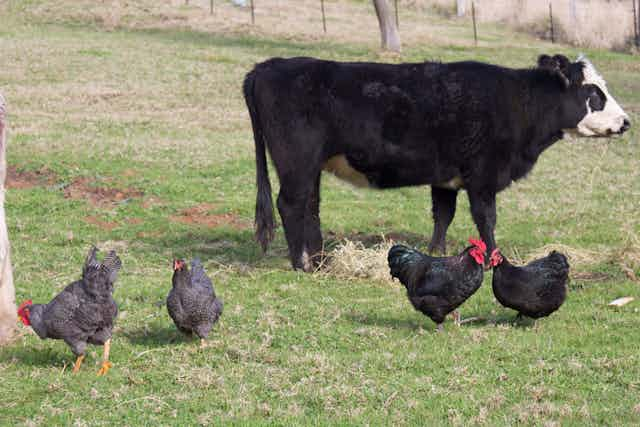Dairy giants Murray Goulburn and Fonterra played a dangerous game of chicken by hanging onto high milk prices despite the global dairy market volatility. Even though both cooperatives are shifting responsibility to each other for the fall in milk prices, which is pushing dairy farmers to the brink, they are both at fault for their race to the bottom. Now both will have to work hard to win back the trust of farmers.
The two companies, both cooperatives (although Fonterra has most of its members in New Zealand) compete head-to-head for farmer suppliers in Australia. Fonterra is the world’s largest dairy exporter accounting for about 40% of global dairy trade and is the fourth largest dairy company behind Nestle, Danone and Lactalis with an annual gross revenue of A$17.61 billion, and 1200 suppliers in Victoria, Tasmania and South Australia. By contrast Murray Goulburn has annual sales revenues of A$2.87 billion, 9% of the global trade market and has 2500 suppliers in Victoria and Tasmania.
Since 2005, when Fonterra purchased Bonlac the two companies have fought for suppliers in Australia and grown their respective businesses to meet increasing global demand for dairy product. Their resulting pricing models to farmers were assured while dairy prices continued to rise. Farmers accepted claw back provisions - it was never thought that they would be invoked - and the companies accepted loose contractual obligations to supply. The competitive environment that ensued, from which dairy farmers benefited meant that neither company was able to hold the mantle of market leader for long.
The game of chicken was on as early as August, 2015 when Fonterra began reducing its advance payments to New Zealand dairy farmers). Throughout the following eight months Murray Goulburn and Fonterra steadfastly sat behind their respective wheels committed to hanging tough. Much was at stake.
For both cooperatives a reduction in advance payments to their suppliers in March, or earlier would have saved them considerable reputational risk, and in many cases reduced the exposure of dairy farmers to financial failure. Instead they chose not to swerve, but to hang tough, failing to ignore the significant decline in global prices, for which they both appeared oblivious.
While Murray Goulburn swerved first by lowering the milk solid price, they did so far too late. Fonterra swerved last, but by then the events in the international market had raced past the game – leaving both companies’ suppliers stranded with the over-payment problem from which they now suffer. Recklessly both cooperatives thought they could run the gauntlet with global dairy. That they actually did so for eight months is testimony to the merits of market competition.
Where to now for the two beleaguered companies and suffering dairy farmers? The benchmark for corporate behaviour and accepting responsibility for ‘bad’ outcomes was set by Johnson & Johnson in 1982.
The handling of the Tylenol crisis, where a series of poisoning deaths resulted from drug tampering, set the standard for corporate ethics against which all other subsequent behaviours can be compared. Johnson & Johnson took responsibility, took action and set about the recovery – despite not being responsible for the tampering of their product on shop shelves in Chicago.
It will be through remedial behaviour by each of the dairy giants over the next months that these cooperatives will re-cement their relationships with suppliers, as they both try to win over farmers and gain disproportionate market share at the others’ expense. The outcome both cooperatives have been seeking since Fonterra’s market entry in 2005.
Fonterra have reiterated the view that they warned farmers that the price paid did not reflect the collapse in global dairy prices yet appear to have left the responsibility to them to manage.
Worse, Fonterra’s CEO, Theo Speirings, has now defended the price cut on the grounds that their strategy is to repatriate profit for the benefit of their New Zealand shareholders. This overlooks that the majority that of tradeable shares are held by Australian superannuation funds and that Fonterra’s Australian suppliers had to be subsidising their New Zealand counterparts. How else do you explain the 30% increase in farm gate price on this side of the Tasman?
By contrast Murray Goulburn’s behaviour, especially that towards their suppliers, appears far more conciliatory. Murray Goulburn has been transparent about resignations from the board and management; open about reorganisation and appointment of their interim CEO, David Mallinson; and, shared with suppliers the prioritisation of effort.
They have now offered suppliers a Milk Supply Support Package designed to spread the impact of lower milk payments across the next three years. This package sits on the cooperative’s balance sheet - where it should - with no need to take on individual loans at supplier level.
Whether or not either company can emulate the recovery of Johnson & Johnson remains to be seen, but it is reasonable to expect considerable energy, effort and enterprise being expended by them in the months that follow.
Telling evidence will be reflected in market share in 12 months.
This piece has been altered since publication to correct Fonterra’s annual gross revenue, which is $A17.61 billion and Murray Goulburn’s annual sales revenue, which is $A2.87 billion.

